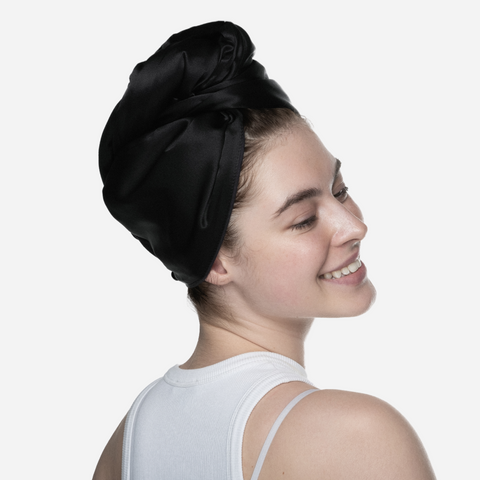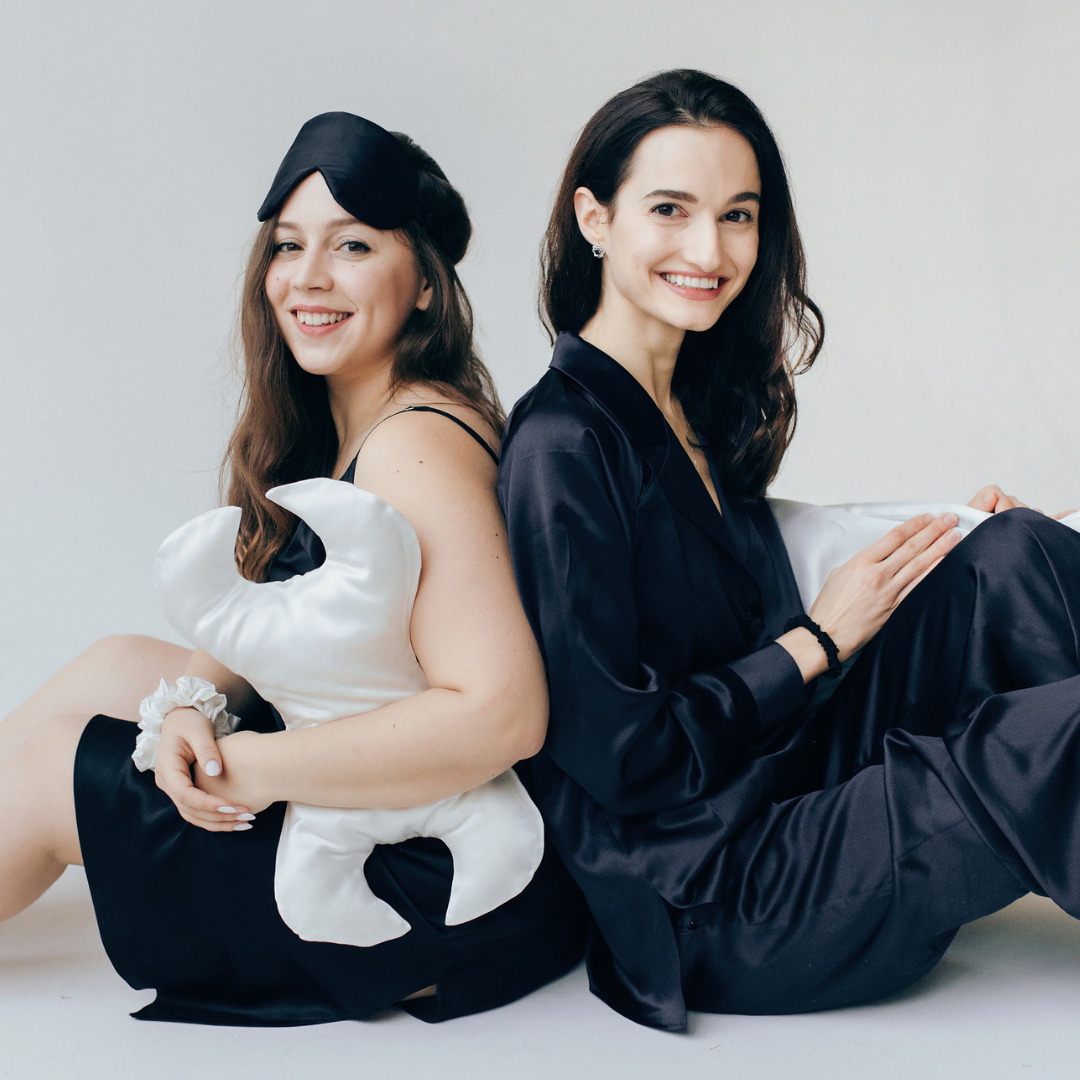Experts assure that a hair-drying turban is the key secret to maintaining healthy and beautiful locks. The truth is that hair is most likely to get damaged after being washed. When it gets wet, its protective layer comes off. If you comb or rub these "bare" strands with rough towels, you can ruin them for good.
Hair turbans dry and treat hair gently after it has been washed. They delicately remove excess moisture, preventing tangles and breakage while making the strands appear stronger and more beautiful. We've previously delved into the various benefits of using turbans.
In practice, however, not all turbans deliver this miraculous impact on the hair. Why? Detail matters: a turban will only do great things for your hair if it is made correctly and from good material.
How to choose the right turban?
- Start by selecting the right shape of accessory that won't tangle and will evenly dry your hair.
- Pay close attention to the size, how it is fastened, and whether or not it has an elastic band around the edges.
- Choose a turban made from the right fabric that won't cause damage but, on the contrary, will enhance the condition of your hair.
We have put together a full guide on the different styles, shapes, and parts of hair turbans to help you choose a useful accessory
What shape and design of hair turban to choose?
The most common turban shapes on the market are the bag-like, cap-like, and elongated triangle variants. You should stay away from the first two choices. Bag-like turbans hardly differ from regular towels, bundling up the hair into one bunch, causing tangles, and not ensuring even drying.

The elongated triangle shape is the best for a turban. This accessory allows you to neatly wrap even the longest strands of hair. It prevents tangling and ensures quick drying, all without the risk of damage.
Many choose to have a band sewn onto the turban's edges. If you have thin and fragile hair, it's wise to avoid this detail. The bands may snag, pull, or damage the strands. It might not be a big deal if it only happens once in a while, but using it a lot could make your hairstyle look a lot less attractive.

Size is a crucial factor to consider when choosing a turban. Overly bulky turbans differ little from classic towels; they can stretch and weigh down the hair. While the hair condition won't worsen instantly. However, the regular use of large and heavy turbans can make strands more brittle and susceptible to external factors.

Another crucial aspect is the turban's practicality. Large ones usually don't secure hair well and may slip off. It's best when the base of the turban is a few centimeters larger than the head's circumference.
Pay attention to small details in accessories, such as the fastening. A small button at the tip of the turban helps keep it in place and, of course, adds a touch of aesthetics to your daily routine.

What fabric should a hair turban be made of?
Since we commonly use terry cloth towels in the bathroom, it might seem like the best choice for a hair turban. However, this is not the case. Terry cloth is too rough a material for delicate wet hair. It acts as an abrasive, lifting the hair cuticles and causing damage. If you rub wet strands with a terry cloth turban, split ends and hair breakage are inevitable.
Plush fabric turbans also have an enticing appearance, at least visually. Yet, they pose the same problem as terry cloth. The stiff and long fibers make the hair look frizzy and damaged.

Fabrics with long fibers are not suitable for drying hair for another reason — they leave small fibers in the strands. This is one of the main reasons for post-wash tangling and difficult combing, resulting in more brittle and dull hair.
Many brands offer an alternative — cotton turbans. This fabric works better than terry cloth because it is lightweight, soft, and absorbs moisture well. However, cotton turbans have their drawbacks. They unevenly absorb moisture, causing hair to dry slower and less uniformly.

Another point to consider is that cotton literally pulls moisture from the hair strands, leading to oversaturation. So, if you have dry and brittle hair, cotton turbans may worsen the situation. Waffle turbans are often made from cotton, so they share the same issues.
Many manufacturers offer turbans made of polyester or fake silk. You should also stay away from these choices. Firstly, such synthetic materials do not absorb water well, which makes the drying process take longer. Second, the synthetic coating is made from materials that contain petroleum products. When these chemicals react with other chemicals in the fabric, they may become toxic or even cancer-causing. If you prefer lightweight fabrics or need a travel-friendly hair accessory, consider a towel made from natural silk.
Experts agree that the best fabric for drying wet hair is microfiber. To begin, its smoothness keeps the hair fibers from rubbing against it, which helps keep the hair from breaking. Trichologists particularly recommend microfiber turbans for individuals with wavy hair, as it doesn't exacerbate frizz and allows curls to form more evenly.
The best thing about microfiber is that it absorbs moisture better than other materials. Wrapping your hair in a microfiber turban right after a shower will result in it drying three times faster (and with less damage) compared to a regular bath towel. A great option when you want a perfect hairstyle without wasting too much time!
What are the benefits of a reversible hair turban?
Most manufacturers offer single-fabric turbans, often made of microfiber, which is already an upgrade to your hair care routine. However, there's a combination that can truly transform your hairstyle: microfiber and silk.
The turban can be worn with the silk side on wet hair (previously dried with the microfiber side) or on completely dry hair. While you go about your activities, this fabric will take care of your hair.
Natural silk is rich in proteins and amino acids, saving your hair from split ends and brittleness and helping maintain the desired length. One more thing is that silk softens hair.
Speaking of styling, after a silk treatment, your curls will become silkier and shinier. A silk turban can help people whose hair is prone to frizz and static because it makes it easier to brush and style.
It is very important to be careful when picking out a turban with a silk side. Many manufacturers offer synthetic substitutes for natural silk, lacking the advantages of the real material. Moreover, synthetic silk can cause allergies in individuals with sensitive scalp skin, as it often contains toxic substances.
The Ukrainian brand MOLODO produces turbans exclusively from high-quality smooth microfiber and natural Mulberry silk (22 momme). The 100% organic Mulberry silk is certified by the Global Organic Textile Standard (GOTS) and Oeko Tex 100, ensuring maximum benefits for your scalp and hair.
It's worth noting that the production of organic silk avoids the use of chemical substances and toxic dyes. Therefore, by choosing turbans, silk towels, or pillowcases made of MOLODO silk, you can be worry-free about allergic reactions on your skin and environmental harm.
Importantly, all silk hair accessories, including silk scrunchies and pillowcases from MOLODO, are handcrafted in their zero-waste workshop in Lviv. Each order comes with a lavender sachet for aromatherapy as a gift.
By choosing MOLODO accessories, you not only care for the health and beauty of your hair but also contribute to the well-being of the planet and enhance the aesthetics of your life!




